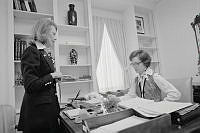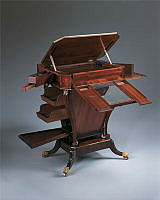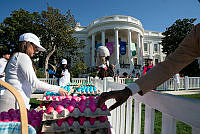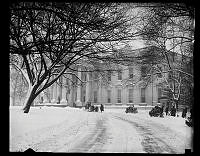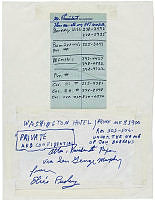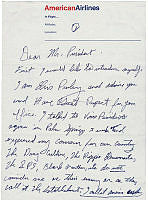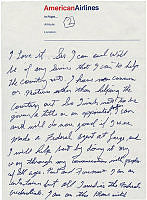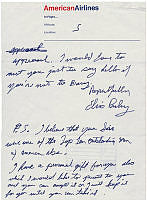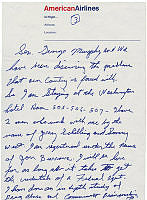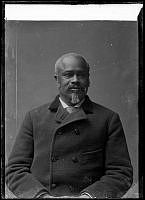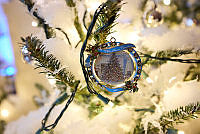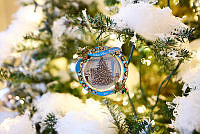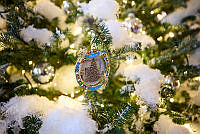Rubenstein Center Scholarship
The White House Chief Usher
A History
The White House Chief Usher serves as the general manager of the Executive Mansion. In addition to administrative and fiscal responsibilities, the chief usher supervises Executive Residence staff, as well as organizes and directs construction and remodeling projects within the home and on the White House Grounds. This position is considered prestigious and well-established, but this was not always the case. During the nineteenth century, White House domestic positions were frequently redefined and reorganized as responsibilities shifted over time. The position of White House Chief Usher gradually evolved at the turn of the twentieth century as presidents and first ladies restructured White House staff roles, expanded presidential workspace, and blended longstanding White House employees with members of their personal household staff.
During the nineteenth century, nearly all administrations featured two critical positions of authority: private secretary to the president and steward. Before the construction of the West Wing in 1902, presidents and their staff worked upstairs on the Second Floor of the White House. The west end was used as the first family’s private quarters, and the east for the president and staff. With little space to spare and sparse funds appropriated by Congress, presidents relied on small executive staffs. The president’s secretary held authority over all other members of the staff. For many nineteenth-century presidents, this person was a male family member or relative. By the 1880s this practice had fallen by the wayside, but the private secretary to the president remained not only the most powerful member of the executive staff but also the highest paid White House employee.1

This hand-colored wood engraving appeared in "Frank Leslie's Illustrated Newspaper" on July 23, 1881 and depicts Sergeant Edson S. Densmore (sometimes spelled Dinsmore) assisting visitors in the Entrance Hall of the White House. Densmore was a sergeant for the Metropolitan Police and assigned to the White House for protective duty. He left his position as a doorkeeper in 1887 and returned two years later as chief doorkeeper, the early iteration of White House Chief Usher. Densmore served in this role until his death in 1892.
White House CollectionThe steward was responsible for managing the domestic staff, coordinating hospitality, arranging social events, cleaning, maintenance, and procuring anything that the president or first family might require or request. During the nineteenth century, most presidents and first ladies brought their own steward to the White House—these were either people that had worked for them previously or came highly recommended by family, friends, or acquaintances. Most stewards only worked for the president who hired them and left at the end of an administration. They were also paid by the first family, as Congress did not appropriate funds for the president’s household expenses. Some did manage to stay longer than a single administration; one such example is William T. Crump, who served as steward for Presidents Rutherford B. Hayes, James Garfield, and Chester A. Arthur.2 Many of these individuals had previous managerial experience working in private households or hotels. They also ran successful catering companies, restaurants, and confectionaries, and shared long-term relationships with the president and first lady that hired them.

This page from the Official Register of 1889 lists the names of Executive Branch employees. While listed as a doorkeeper, E.S. Densmore makes the highest salary among them.
Hathitrust.orgNear the turn of the twentieth century, Executive Mansion operations began to shift as a new civil service position was officially created in 1889-1890: chief doorkeeper. Prior to this, the term “chief usher” was used frequently in the press, hence the confusion about when exactly this role came into existence. In fact, there are mentions of the “chief usher” dating back to the Ulysses S. Grant administration, as critics charged that President Grant hired his brother-in-law General Frederick T. Grant for the position. This accusation was not true, as Frederick was hired as one of three presidential secretaries, along with Generals Horace Porter and Orville E. Babcock.3 In August 1887, one newspaper reported that “John McKenna, of Troy, N.Y., has been appointed chief usher and doorkeeper at the White House in place of E.S. Densmore, resigned.”4 According to the 1889 Official Register, the highest-paid positions among the White House domestic staff were the steward ($1,800) and the doorkeeper to the president ($1,600); this person regulated access to the president and coordinated the president’s schedule and visitations with their executive staff. There were also five additional doorkeepers—four were paid $1,200, but one doorkeeper, Edson S. Densmore, was paid the same salary as the steward--$1,800.5 A year later, “chief doorkeeper” appeared for the first time in appropriations legislation: “For compensation to the following in the office of the President of the United States…steward, at one thousand eight hundred dollars; doorkeeper to the President, at one thousand six hundred dollars; four messengers, at one thousand two hundred dollars each; chief doorkeeper, one thousand eight hundred dollars; four doorkeepers, at one thousand two hundred dollars each.”6 It is also worth noting that the chief doorkeeper and steward were paid the same salary, which suggests that two positions were in some measure managerial equals.

This page from the Official Register of 1891 lists the names of Executive Branch employees. E.S. Dinsmore continued to make the highest salary among doorkeepers, but he now has a new title—chief doorkeeper.
Hathitrust.orgThis evidence suggests that Edson S. Densmore (sometimes spelled Dinsmore) was the first official White House Chief Doorkeeper, a position that later assumed the responsibilities of the steward—but who was he? According to government and census records, Densmore was born around 1849 in Chelsea, Vermont. By 1870, he was working as a carpenter in Washington, D.C., and he soon thereafter joined the Metropolitan Police. He rose to the rank of sergeant and was later assigned to the White House.7 Densmore left the Executive Mansion in 1887 but returned two years later. He worked with steward Hugo Ziemann and doorkeeper to the president Charles Loeffler, and all three men were paid the same amount--$1,800.8 Densmore served in this role until he became increasingly ill and died on November 13, 1892. Obituaries consistently state that he began working at the White House during the Rutherford B. Hayes administration, and was first appointed to a doorkeeper position by Grover Cleveland. He resigned his doorkeeper position in 1887 but returned two years later, and Benjamin Harrison elevated him to “chief doorkeeper.”9

This 1900 census record lists William Dubois’ occupation as “Chief Usher, White House.”
Ancestry.comDensmore’s position remained vacant until the following spring. According to a Detroit Free Press article dated March 21, 1893, “a Michigan man this morning became chief usher of the executive mansion. The lucky man is Charles E. Dexter of Three Rivers, ex-Sheriff of St. Joseph County. His position pays $1,800 per year and is practically a life appointment. The place has been vacant since the death of Capt. Densmore, who long held the position. Mr. Dexter was at work at the executive mansion this afternoon and created a very favorable impression.”10 The 1893 Official Register, taken that July, confirms that Dexter was chief doorkeeper of the White House.11 Four doorkeepers reported to Dexter; among them was William DuBois, who would succeed Dexter when he left to work as a post office inspector in December 1895.12 The following June, DuBois was elevated to chief doorkeeper. According to an article from The Evening Star, DuBois had been working at the White House since the early 1880s as a member of the Metropolitan Police and later became a doorkeeper in 1892.13 His previous experience in law enforcement matched those of Densmore and Dexter, the former a D.C. sergeant and the latter a sheriff—this suggests that the chief doorkeeper and their doorkeepers were at this time more responsible for maintaining order, regulating the flow of visitors and guests, and preventing any disturbances or unwanted intrusions.14 According to the 1900 census, DuBois’ listed occupation was “Chief Usher, White House.”15

In this photograph, taken on April 14, 1938, former White House Chief Usher Raymond Douglas Muir shakes hands with his successor, Howell G. Crim. Muir began serving as chief usher in 1933 and resigned from his position to become assistant to the Chief of the International Division of the State Department. Crim served as chief usher of the White House until 1957. The chief usher oversees the management of the building and residential staff of the White House. In the center of the photograph is Charles K. Claunch, a former member of the navy who was appointed an usher at the White House by President Franklin D. Roosevelt. In 1954, Claunch became Government Secretary of the United States Virgin Islands.
Library of CongressDuring the Theodore Roosevelt administration, the White House experienced both a staff expansion and administrative reorganization. An African-American man named Henry Pinckney would be the last person to serve as White House steward before that position was eliminated. Chief Usher William DuBois asked to be reassigned and his replacement, Thomas E. Stone, was announced on March 20, 1902 by the president’s secretary, George B. Cortelyou. Stone had been appointed a doorkeeper at the White House under President William McKinley. The two men first met when Stone worked for the Pullman Company, as McKinley frequently used Pullman cars for his travels.16 Even though his official title in the government register was “chief doorkeeper,” Stone signed correspondence and reports “T.E. Stone, Chief Usher.”17 At the beginning of Roosevelt’s presidency, there was a steward, chief doorkeeper, and four doorkeepers at the White House. By 1903, four more doorkeepers had been added, and all eight reported directly to the chief doorkeeper. Within this group was Stone’s eventual successor, Irwin “Ike” Hoover.18 Hoover had been working at the White House in various capacities since 1891 when he assisted with the installation of electricity in the Executive Mansion. According to newspaper reports, Stone was reassigned to replace Major Charles D.A. Loeffler as doorkeeper to the president and Hoover was elevated to chief usher in 1909.19 He remained in the position until his death in 1933—the first time that a chief usher served multiple administrations and occupants representing both political parties. Hoover was so beloved that President Franklin Roosevelt offered the East Room to the Hoover family for his funeral service, but they declined.20 A year later, Hoover’s notes and observations from his time working at the White House were published posthumously as Forty-Two Years in the White House.

This photograph by Abbie Rowe of the National Park Service shows President Harry Truman and First Lady Bess Truman the night they returned to the White House following the completion of its four-year renovation. Left to right: Charles K. Claunch, Usher; President Truman; Howell G. Crim, Chief Usher; Mrs. Truman; Alonzo Fields, Maître d'hôtel; and J. B. West, Usher. At far right, William Kelly, Project Manager, Public Buildings, and Jess Larson, General Services Administration, admire the ceremonial White House key they are about to present to the President.
Harry S. Truman Presidential Library and Museum/NARAHoover was the first of many civil servants who served well beyond the president that appointed them, marking another key transformation of the chief usher role. In 1925, Hoover was listed in the Official Register as the "head usher" within the Executive Office. Hoover's successor Raymond Muir (1933-1938) was listed as head usher until 1937, when his title was changed to "chief usher" in the Official Register.21 Muir served in the position for only five years and left for the Department of State, but the next four chief ushers—Howell G. Crim (1938-1957), J.B. West (1957-1969), Rex Scouten (1969-1986), and Gary Walters (1986-2007) worked for twelve administrations over a span of sixty-nine years. Recently, there have been two historic firsts for the position. In 2007, Rear Admiral Stephen W. Rochon was hired for the position; he was the first African American in history to serve as White House Chief Usher. Four years later, Angella Reid made history as the first woman (and the first African-American woman) to serve as White House Chief Usher. Rochon and Reid’s tenures were relatively short, as was Timothy Harleth’s (2017-2021). It seems as though the position has reverted back to earlier times when the person in the role only works for the president that hires them—more akin to the nineteenth-century steward.22 Only time will tell if this is just an anomaly or a new trend in the storied history of individuals who dedicated their careers to the White House and the presidency.

Three White House Chief Ushers pose at the foot of the Grand Staircase in 2008. Left to right: Rex Scouten held the position of chief usher from 1969 to 1986; Gary Walters from 1986 to 2007; and Rear Admiral Stephen W. Rochon, USCG (ret.) from 2007 to 2011.
White House Historical Association




